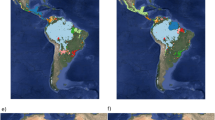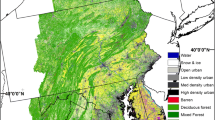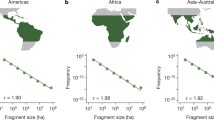Abstract
Recent studies have related percolation theory and critical phenomena to the spatial pattern of landscapes. We generated simulated landscapes of forest and non-forest landcover to investigate the relationship between the proportion of forest (Pi) and indices of patch spatial pattern. One set of landscapes was generated by randomly assigning each pixel independently of other pixels, and a second set was generated by randomly assigning rectilinear clumps of pixels. Indices of spatial pattern were calculated and plotted against Pi. The random-clump landscapes were also compared with real agricultural landscapes.
The results support the use of percolation models as neutral models in landscape ecology, and the performance of the indices studied with these neutral models can be used to help interpret those indices calculated for real landscapes.
Similar content being viewed by others
References
Ambrose, J.P. and Bratton, S.P. 1990. Trends in landscape heterogeneity along the borders of Great Smoky Mountains National Park. Conserv. Biol. 4: 135–143.
Bowen, G.W. and Burgess, R.L. 1981. A quantitative analysis of forest island pattern in selected Ohio landscapes. ORNL Environ. Sciences Div., Publ. ORNL/TM-7759.
Burrough, P.A. 1986. Principles of GIS for land resources assessment. Clarendon Press, Oxford.
Cale, W.G., Henebry, G.M. and Yeakley, J.A. 1989. Inferring process from pattern in natural communities. BioScience 39: 600–605.
Carrere, V. 1990. Development of multiple source data processing for structural analysis at a regional scale. Photogramm. Eng. and Remote Sensing 56: 587–595.
Forman, R.T.T. and Godron, M. 1986. Landscape Ecology. John Wiley and Sons, New York.
Gardner, R.H., Milne, B.T. and O'Neill, R.V. 1987. Neutral models for the analysis of broad-scale landscape pattern. Landscape Ecol. 1: 19–28.
Graham, R.L., Hunsaker, C.T., O'Neill, R.V. and Jackson, B.L. 1991. Ecological risk assessment at the regional scale. Ecological Applications 1: 196–206.
Harris, L.D. 1984. The fragmented forest: Island biogeography theory and the preservation of biotic diversity. University of Chicago Press, Chicago.
James, M. 1988. Pattern recognition. J. Wiley & Sons. New York.
Krummel, J.R., Gardner, R.H., Sugihara, G., O'Neill, R.V. and Coleman, P.R. 1987. Landscape patterns in a disturbed environment. Oikos 48: 321–324.
Mandelbrot, B.B. 1983. The fractal geometry of nature. W.H. Freeman, San Francisco.
Milne, B.T. 1988. Measuring the fractal geometry of landscapes. Applied Mathem. and Computation 27: 67–79.
Milne, B.T. 1991. Lessons from applying fractal models to landscape patterns.In Quantitative Methods in Landscape Ecology. pp. 199–235. Edited by Turner, M.G. and Gardner, R.H. Springer-Verlag, New York.
O'Neill, R.V., Krummel, J.R., Gardner, R.H., Sugihara, G., Jackson, B., DeAngelis, D.L., Milne, B.T., Turner, M.G., Zygmut, B., Christensen, S.W., Dale, V.H. and Graham, R.L. 1988a. Indices of landscape pattern. Landscape Ecol. 1: 153–162.
O'Neill, R.V., Milne, B.T., Turner, M.G. and Gardner, R.H. 1988b. Resource utilization scales and landscape pattern. Landscape Ecol. 2: 63–69.
Orbach, R. 1986. Dynamics of fractal networks. Sci. 231: 814–819.
Senft, R.L., Coughenour, M.B., Bailey, D.W., Rittenhouse, R.L., Sala, O.E. and Swift, D.M. 1987. Large herbivore foraging and ecological hierarchies. BioScience 37: 789–799.
Stauffer, D. 1985. Introduction to percolation theory. Taylor and Francis, London.
Turner, M.G. 1989. Landscape ecology: the effect of pattern on process. Ann. Rev. Ecol. Syst. 20: 171–197.
Turner, M.G., Gardner, R.H., Dale, V.H. and O'Neill, R.V. 1989. Predicting the spread of disturbance across heterogeneous landscapes. Oikos 55: 121–129.
Turner, M.G. 1990. Landscape changes in nine rural counties in Georgia. Photogramm. Eng. and Remote Sensing 56: 379–386.
Urban, D.L., O'Neill, R.V. and Shugart, H.H., Jr. 1987. Landscape Ecology. BioScience 37: 119–127.
Author information
Authors and Affiliations
Rights and permissions
About this article
Cite this article
Gustafson, E.J., Parker, G.R. Relationships between landcover proportion and indices of landscape spatial pattern. Landscape Ecol 7, 101–110 (1992). https://doi.org/10.1007/BF02418941
Issue Date:
DOI: https://doi.org/10.1007/BF02418941




